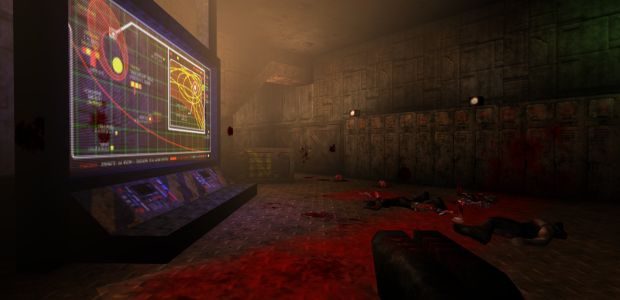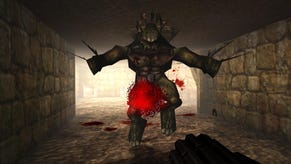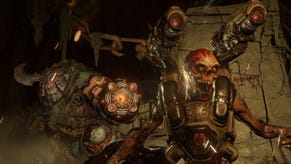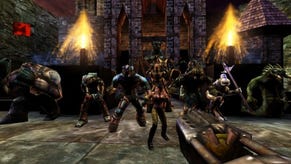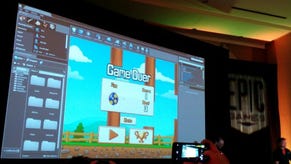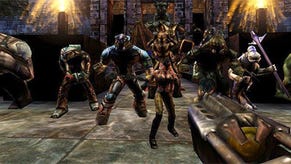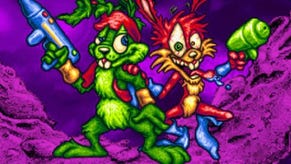A retrospective of Unreal, from the people who made it
20 years later...
Unreal turned 20 years old this month. The extraterrestrial first-person shooter spawned (and showcased) a game engine whose descendants still motor on today. To commemorate all those screaming prisoners and innocent alien creatures killed at the hands of jumpy players, I got in touch with a handful of the original team and asked them to share their memories of making the first Skaarj conflict. This is how Unreal was made, from the perspective of the programmers, designers, artists and musicians who were there.
“Working for Digital Extremes on Unreal was my first full-time job as an artist,” says Mike Leathem, who still works for the studio. “[And my first] experience working with digital media (at ALL, I had never even seen a drawing tablet before)...
“So all of it was exciting and at the same time terrifying - impostor syndrome vs. so many possibilities. I had no idea what I was doing, and every day I learned something-- about how to use the tools, about how much depth you could fake with pixels on a flat polygon... about the trade-off between cool ideas and things that could get done on time.”
That particular lesson, about which artistic visions would make it into the game proper, is something he remembers thanks to the game’s wildlife. Unreal has some jump, rat-like creatures, scuttling around the player’s shins on the alien planet. But Leathem hadn’t originally imagined them this way.
“I don't remember who proposed that there should be, like, background animals, but I remember making a sketch for a Nali cow, and being disappointed that the version in-game was only given the polygon budget for two legs and a tiny tail, instead of the vaguely stegosaurian proportions I wanted.”
But he remembers this, he says, with a smile. It was a project that lacked the structure of modern-day development, but one that also gave creators great freedom.
“It was a wild ride, by my tame standards - it felt to me like whatever people wanted to do, and could do well, got included.”
That sense of possibility doesn’t end with Leathem and his alien rat-cows. All the developers I spoke to shared the feeling of being on a game-making frontier. They were following the template solidified by Doom, yes, and were also following Quake, the first shooter to use a truly 3D engine, a fast-paced FPS that let you shoot polygonal enemies with grenades that bounced round corners (not to mention the ability to frag other humans over a LAN or the early internet). Quake II would also be released months before Unreal. But, according to Tim Sweeney, who was a leading programmer on the project, the team working on Unreal were making their own breakthroughs.
“As a programmer, the most amazing thing about Unreal development for me was the sheer number of industry firsts we got to see throughout development,” he says.
Sweeney is the founder of Epic Games (although it was called Epic MegaGames when Unreal was in the works) and he remains the company’s CEO today. The game was made by two companies – Epic and Digital Extremes. So when it comes to Unreal, Sweeney is quick to give credit wherever it’s due, rhyming off name after name. He clearly takes pride in the shooter’s details, in its flames, fog and waterfalls. But I also get the feeling he’s making sure I don’t leave anyone out.
“James Schmalz’ gorgeous 3D models with true-color artwork animating perfectly smoothly at 30 FPS using vertex interpolation. Exiting the tiny crashed spaceship at the start and seeing a large outdoor scene with a canyon and a waterfall, in real-time 3D for the first time - built by Pancho Eekels. Building the first real-time volumetric fog system and then seeing Shane Caudle’s underground temple with its fog-filled chambers with real-time fire and water by Erik de Neve."
“And after a couple years of building all of this beautiful but sort-of lifeless content, seeing it all come alive with Steve Polge’s ReaperBot-inspired AI system... with the first Skaarj encounter that Cliff Bleszinski designed.
“It was a magical time in the early history of 3D that saw breakthroughs almost daily.”
But Sweeney, along with Cliff Bleszinski, didn’t just want the alien baddies to dodge bullets and the sloping canyons to look good. They wanted the world to sound good too. The game’s composer, Alexander Brandon, makes the process of petitioning a studio head seem straightforward.
“I could see early on that the game was going to be special," he says. "So I grabbed Michiel [Van Den Bos, a fellow composer], walked into Tim Sweeney’s office and said: ‘We’d like to do the score for this game, is that ok?’ And he said: ‘Yeah, definitely!’"
The studio was pushing for ‘interactive music’ in a way that felt entirely new to Brandon. This would be music that reacted to the player’s actions and position, rather than simply play on a loop for an entire level.
“We had conversations that are commonplace now but not commonplace back then: what happens if the player goes back and forth across a music trigger? We can’t have the music switching constantly. So do we use a timer? Distance? It was a whole new way to think of how to score a game. This was in 1997, so this whole concept is now old enough to drink.
“And collaborating with Michiel Van Den Bos created a style that wasn’t done before and really hasn’t been done since for the soundtrack... The whole process was exciting from start to finish. We wrote tracks. They went in. And I don’t think we revised much of anything at all.”
Brandon would go on to work on the Deus Ex soundtrack with two other Unreal alumni, Michiel Van Den Bos and Dan Gardopée. One of his only regrets is that the score of Unreal wasn’t released separately. The soundtrack got a limited release along with other merchandise (in one instance it came packaged with a strategy guide) but Brandon wanted the score sold separately, and he asked both Epic and publisher GT Interactive if this could be done.
“My requests either got ignored or turned down,” he says. “It’s definitely a regret I still have, but many, many composers struggle to get their scores released separately. It requires legal attention and marketing like any other release. The essential part of the argument is to convince the parties that be that it’s financially worth it. And just now with the popularity of soundtracks? It is totally worth it.”
Brandon isn’t the only one with strong memories of the game’s music being recorded. According to Artur Bialas, one of the game’s artists, if you walked through the Digital Extremes studio in Waterloo, Ontario, at the height of development, past the “Mountain Dew pyramid”, past co-workers eating their dish from ‘Curry In A Hurry’, and past the pet huskies of your colleagues, you’d reach the lobby of the building and find the sound team recording music for the Nali levels. Also: the boss playing the sax.
“We recorded a live session of conga drums and I think at one time Tim Sweeney was playing some really cool riffs on saxophone,” says Bialas.
Bialas was an artist, creating textures and skins no bigger than 256x256 pixels, which meant getting creative when it came to something as detailed as alien signposts.
“The Skaarj writing was based on ancient Cuneiform scripts,” he says. “We had fun creating other alien writing systems that appear throughout the game.”
Even some of the basic 3D elements started in the roughest manner possible. Early in development, the team used clay models, which they scanned digitally into the game.
“The hand that was holding the guns was a mold of one of the developers hands,” he says. “Unfortunately I think none of the models stayed in the game, or they were heavily modified. Once we fully switched to 3D applications like 3DMax and Maya all the assets were built using those applications.”
As one of the makers of these raw materials, Bialas also remembers being approached for favours by individual level designers, who had a lively culture of oneupmanship.
“There was a little competition happening between the different level designers and they would constantly ask the artists to create custom/special textures for their levels.”
Even today, if you play through Unreal Gold, you’ll notice that every level begins with a credit: the name of the level and the name of the ‘author’ who designed it. Mothership Basement by Cedric ‘Innox’ Fiorentino. Ceremonial Chambers by Elliot ‘Myscha’ Cannon. Rajigar Mine by Cliff Bleszinski. Just like Sweeney, the level designers wanted credit where it was due. And they weren’t beyond making special requests of artists like Bialas if it meant their temples, lairs and villages were more exciting than those of their peers.
Friendly rivalries and music in the lobby is a happy way to remember the creation of Unreal (a “triumphant reality to gamers around the world” as one particularly hype press release put it). But there was also crunch, a punishing aspect of work culture in the games industry that still hasn’t gone away.
“It was both brutal and horrible,” says James Schmalz, lead designer. “And exciting and amazing.”
“I remember the last year of legit 70-80 hour work weeks with the team knowing we were making something very special. We could see the excitement building with the new Unreal community and we knew we had a lot to live up to. We were 20-something’s and were willing and had the energy to make the sacrifice to really bring it all together to make it special. But it definitely took an emotional toll, no doubt.”
Schmalz is still the head of Digital Extremes, the studio now known for free-to-play shooter Warframe. He’s also the man who started it all, when he showed off the side project that would become Unreal to Cliff Bleszinski in 1994. Later, he showed his work to Tim Sweeney of Epic MegaGames, who was so appalled at the thought of Schmalz designing all his levels using pen and paper that he started working on a level editor for them. By now, the two companies were in it together. And they weren’t so much “in for a penny, in for a pound” as they were “in for a million”.
“The excitement was knowing we were making something big. Something that would compete with the other big games of the time,” says Schmalz. “And kinda knowing we were putting everything we had into it. Financially, emotionally and creatively.
“It was all in. Personally, I had put about $1M into it, so from my perspective failure was NOT an option. At all. There is something to be said about letting everything you have be out on the line. It’s both incredibly exciting and tremendously nerve-wracking.”
As work continued, that high emotion in the studio could spill over into disagreements and angry exchanges. When I ask Alexander Brandon, the game’s composer, whether he has any bittersweet memories, he tells me about the stressful run-up to E3 one year.
“[W]e needed more music to demonstrate the game at an E3,” he explains. “We only had two or three songs that everyone was getting tired of after months, and were working on more but were also waiting on seeing more of the game as well.
“As E3 loomed, a few emails got sent out that, needless to say, were not happy about the production speed of the soundtrack at that time. All-caps swear words with several dozen exclamation marks.
“Of course, you can’t hear music at all during E3 due to the loudness of the floor. And years later I’d see the guy who sent that email and he greeted me with an enthusiastic hello and warm smile.”
The game missed internal deadlines, suffered delays, and lots of assets were made that never got used. Those final days in particular were crazy, says Brandon. “But we all got through ‘em.”
When the project did end, it ended in a way that’s increasingly rare today. Work stopped, the game had shipped, and that was it. Unreal was finished and it was all on the CD-ROM. There was no ‘day one patch’.
“The [memory] that sticks out to me is finishing,” says Schmalz. “We were working our asses off so hard and for so long. And then, one day, at a certain hour, it was just done. Done. It was surreal. Working 70-80 hour weeks and then full stop. It was an odd but incredibly rewarding feeling… Definitely a ‘life moment,’ which I would never trade for anything. It helped define who we are.”
“We had people from all over the world working in the studio,” says Bialas. “Soon after the game went live, the team went back to their respective homes. Some of us would not see each other after that until many years later. I miss the camaraderie of that team and that sense of working on something that is on the forefront of innovation.”
You can still play this 20-year-old shooter today, in the form of Unreal Gold (Epic recently gave it away for free on its birthday). And it holds up surprisingly well. There are tense moments, cinematic traps, dark corridors, and thick-skinned enemies who dodge your fire. Unreal deserves its place not just in first-person shooter history, but in the history of videogames as a whole. The engine behind the game, by itself, has been massively influential.
The machine built for Unreal went on to power Deus Ex. Follow-ups of the Unreal engine have since been used for a litany of games from BioShock to Mass Effect to XCOM: Enemy Unknown (although we can give a bad example too: Duke Nukem Forever, which was already a year in development when Unreal came out in 1998). That influence is lasting. Even if you’re a Quake lifer, or if you’re too young to have done combat with the Skaarj, you’ve probably still played a bit of Unreal.





